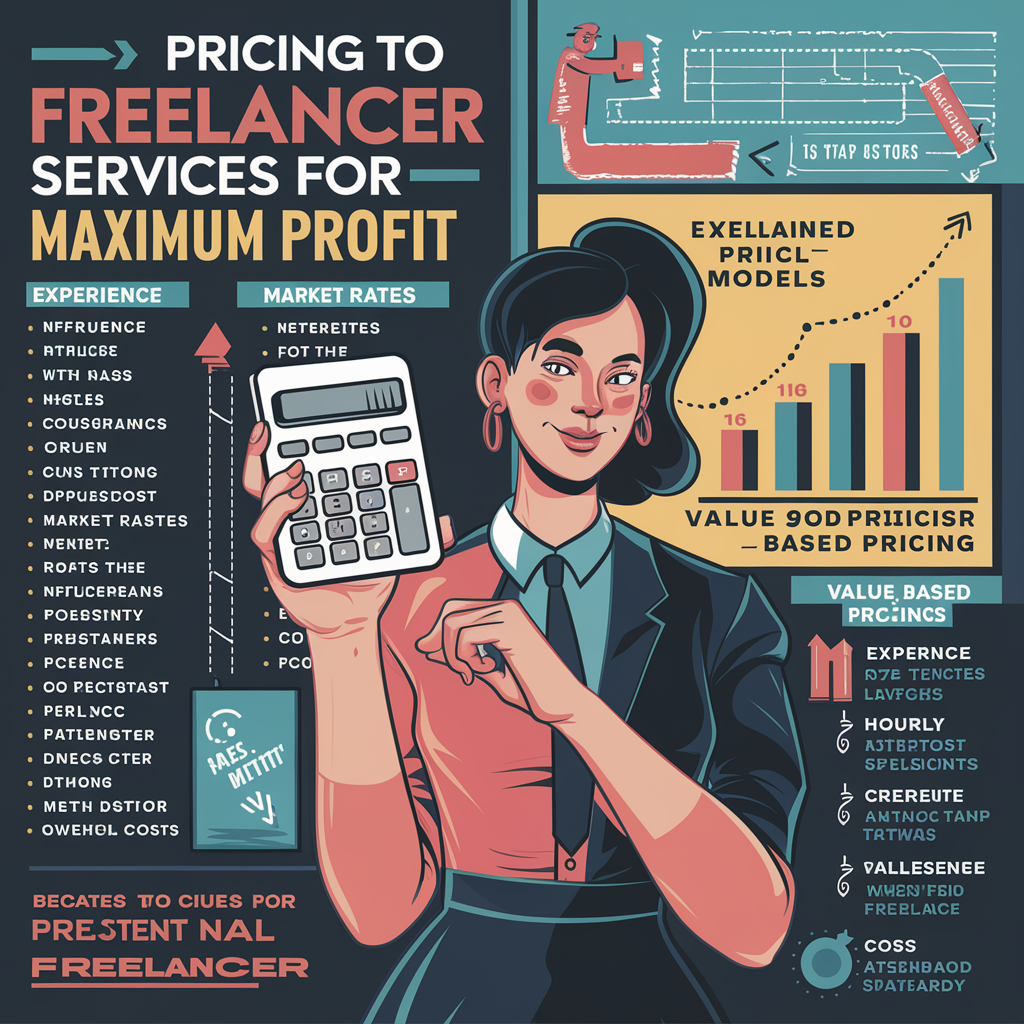JavaScript For Kids
“JavaScript Explorers: Fun and Easy Coding for Kids” is a vibrant and interactive ebook designed to introduce children to the exciting world of JavaScript programming. Through colorful illustrations, step-by-step instructions, and hands-on coding exercises, young learners will embark on a fun-filled journey to discover the fundamentals of JavaScript in a playful and engaging way. With…
Introduction:
Pricing your freelance services can be one of the most challenging aspects of freelancing. Charge too little, and you undervalue your work and struggle financially. Charge too much, and you risk losing potential clients. Striking the right balance is crucial for ensuring maximum profit while maintaining a steady stream of clients. This article will provide a comprehensive guide on how to price your freelance services effectively, with practical examples to help you make informed decisions.
Understanding Your Value
- Assess Your Skills and Experience:
- The first step in pricing your services is to evaluate your skill set and experience level. More experienced freelancers can charge higher rates due to their expertise and proven track record.Example:
- If you’re a graphic designer with ten years of experience and a strong portfolio, you can justify charging more than a beginner with one year of experience.
- The first step in pricing your services is to evaluate your skill set and experience level. More experienced freelancers can charge higher rates due to their expertise and proven track record.Example:
- Market Research:
- Conduct research to understand what other freelancers in your industry and region are charging. This will give you a benchmark and help you position yourself competitively.Example:
- Use platforms like Upwork, Fiverr, and LinkedIn to check the rates of freelancers with similar skills. If you find that experienced web developers charge between $50 and $100 per hour, you can use this range to set your rates.
- Conduct research to understand what other freelancers in your industry and region are charging. This will give you a benchmark and help you position yourself competitively.Example:
Pricing Strategies
- Hourly Rate vs. Project-Based Pricing:
- Hourly Rate: Charging by the hour is straightforward and ensures you get paid for every minute of work. However, it might limit your earning potential if you’re highly efficient.Example:
- If you charge $50 per hour and work 20 hours a week, you will earn $1,000 weekly. However, if a project takes you less time than anticipated, you might earn less than a project-based fee.
- Project-Based Pricing: This approach involves charging a flat fee for the entire project, regardless of the time it takes. It can be more profitable if you work quickly and efficiently.Example:
- You quote $2,000 for a website redesign project. If you complete the project in 30 hours, your effective hourly rate is about $67, higher than your typical hourly rate.
- Hourly Rate: Charging by the hour is straightforward and ensures you get paid for every minute of work. However, it might limit your earning potential if you’re highly efficient.Example:
- Value-Based Pricing:
- Value-based pricing focuses on the value you provide to the client rather than the time spent. This strategy can significantly increase your earnings if your work directly impacts the client’s revenue or success.Example:
- If you’re a copywriter creating a sales page that could potentially generate $100,000 in sales for the client, charging $5,000 for the project reflects the value of your contribution.
- Value-based pricing focuses on the value you provide to the client rather than the time spent. This strategy can significantly increase your earnings if your work directly impacts the client’s revenue or success.Example:
Calculating Your Rates
- Determine Your Expenses:
- Calculate your monthly expenses, including rent, utilities, software subscriptions, taxes, and other business costs. This will help you understand your minimum income requirements.Example:
- If your monthly expenses total $3,000, you need to earn at least this amount to break even. Consider adding a buffer for savings and unforeseen expenses.
- Calculate your monthly expenses, including rent, utilities, software subscriptions, taxes, and other business costs. This will help you understand your minimum income requirements.Example:
- Set Your Income Goals:
- Decide how much you want to earn annually and break it down into monthly and weekly targets. This helps in setting realistic rates to achieve your financial goals.Example:
- If you aim to earn $60,000 annually, you need to make $5,000 per month. Dividing this by the number of billable hours per month will give you a baseline hourly rate.
- Decide how much you want to earn annually and break it down into monthly and weekly targets. This helps in setting realistic rates to achieve your financial goals.Example:
Negotiating and Adjusting Rates
- Be Transparent with Clients:
- Clearly communicate your pricing structure to clients. Transparency builds trust and helps clients understand the value they receive.Example:
- Provide detailed quotes outlining the scope of work, estimated time, and costs. If clients understand what they’re paying for, they’re more likely to accept your rates.
- Clearly communicate your pricing structure to clients. Transparency builds trust and helps clients understand the value they receive.Example:
- Adjust Rates Based on Demand:
- If you find yourself consistently booked and turning away clients, consider raising your rates. Conversely, if you struggle to find work, you might need to adjust your pricing or offer discounts.Example:
- After a year of consistent work and high demand, you decide to increase your hourly rate from $50 to $60. This adjustment reflects your growing expertise and market value.
- If you find yourself consistently booked and turning away clients, consider raising your rates. Conversely, if you struggle to find work, you might need to adjust your pricing or offer discounts.Example:
Conclusion
Pricing your freelance services for maximum profit requires a balance of understanding your value, market research, and strategic pricing. Whether you choose hourly, project-based, or value-based pricing, the key is to remain flexible and adjust your rates as your skills and market demand evolve. By setting clear income goals and being transparent with clients, you can ensure a steady stream of work and financial stability. Remember, your pricing should reflect the quality and value of the services you provide.
FreelancePricing #FreelanceBusiness #Freelancing #PricingStrategy #FreelanceRates #HourlyRate #ProjectBasedPricing #ValueBasedPricing #FreelanceTips #FreelanceSuccess #BusinessAdvice #FreelanceLife #FreelanceIncome #PricingYourServices #FreelanceWork #Entrepreneurship #FreelanceMarket #NegotiatingRates #FreelanceGoals #MaximizeProfit







Very nice post but the sad truth is you have to offer much better service at lower price than competitors to get hired.
Thanks for your reaction, I think you must create quality and propose heigher price